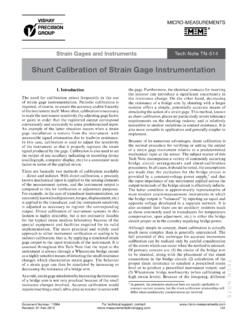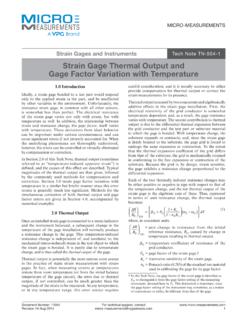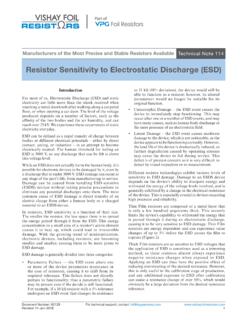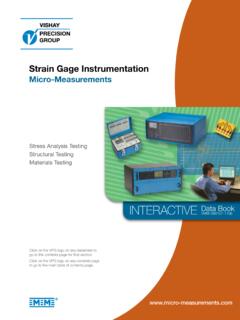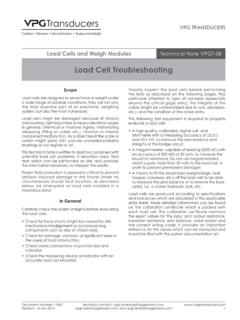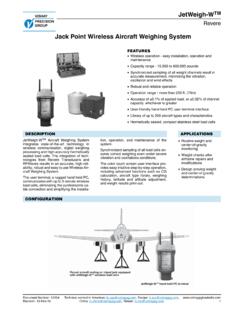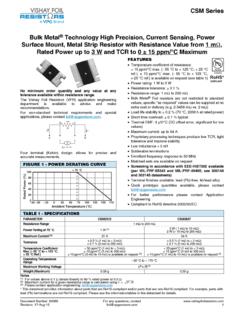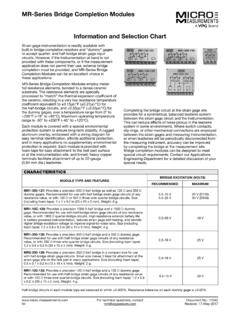Transcription of Standard Weldable Patterns - Datasheet
1 For technical questions, No.: 11519 Revision: Weldable PatternsSpecial Use Sensors Weldable strain GagesSpecial Use Sensors Weldable strain GagesMicro-Measurements Standard Weldable strain Gages and Temperature Sensors are specially designed for spot welding to structures and components. They are ideal for applications where test or environmental conditions preclude clamping and curing an adhesively bonded gage installation. These gages are equally advantageous when strain measurements must be made at an elevated temperature, but the nature of the test object does not permit the use of an elevated-temperature-curing preparation requirements are minimal; only an appropriate solvent cleaning and abrasion of the test part surface with silicon-carbide paper or a small, hand-held grinder is needed.
2 Spot welding is accomplished with a portable stored-energy hand-probe spot welder, such as the Model 700. Environmental protection is as easily applied to a welded gage installation as to an adhesively bonded to Instruction Bulletin B-131 and MM strain gage Accessories Data Book for further information on installation and protective coatings. For specifications about the Model 700 Welding/Soldering Unit, please refer to the product AND PERFORMANCEG eneral All sensors are laboratory-prebonded, with a high-performance adhesive, to thin [ in ( mm)] metal carriers. Sensor grids are fully encapsulated for protection against handling and installation damage. Standard Weldable strain gages are offered in two series to meet differing performance requirements.
3 Both series are available in either 06 or 09 self-temperature compensation. strain gages with 06 S-T-C have Inconel carriers, while S-T-C 09 gages and temperature sensors are mounted on 300-series stainless Weldable strain gage Polyimide-encapsulated constantan foil grid, with large, rugged, copper-coated tabs. In most cases, the carrier can be contoured to a radius as small as 1/2 in (13 mm). The CEA Series is ideal for direct leadwire attachment, before or after range is 5000 in/in ( 5000 m/m), and normal operating temperature range is 100 to +200 F ( 75 to +95 C). Short-term maximum temperature is +300 F (+150 C).LWK-Series Weldable strain gage Nickel-chromium alloy grid, encapsulated in fiberglass-reinforced epoxy phenolic. The LWK gage is provided with a three-wire lead system with 10 in (250 mm) of Teflon -insulated construction simplifies leadwire temperature compensation and provides for easy connection of the lead system to the instrumentation cable.
4 Minimum installation radius is generally limited to 2 in (50 mm). strain range is 5000 in/in ( 5000 m/m), and normal operating temperature range is 320 to +500 F ( 195 to +260 C). Short-term maximum temperature is +550 F (+290 C).WWT-Series Temperature Sensor High-purity nickel foil grid encapsulated in fiberglass-reinforced epoxy-phenolic, and equipped with integral three-tab terminal to facilitate leadwire attachment. The temperature sensor is normally installed on a flat surface of the workpiece, but, in any case, should always be oriented with the gridlines in the direction of minimum strain to avoid strain -induced errors (see Micro-Measurements Tech Note TN-506, Bondable Resistance Temperature Sensors and Associated Circuitry ). With an appropriate LST Matching Network, the temperature response characteristic of the nickel can be linearized and scaled for direct readout (in degrees) with any strain Weldable strain GAGESM icro-Measurements also offers a line of sealed Weldable strain gages that have a polymer coating in place that offers instant protection from moisture.
5 Please see the Datasheet available at: CONSIDERATIONSIt is important to note that operating characteristics of Weldable strain gages ( gage factor, transverse sensitivity, and thermal output) are specified for the basic strain gage itself without the metal carrier. Thus, the properties are measured by bonding a conventional strain gage directly to an appropriate calibration specimen, following Standard methods specified for all Micro-Measurements strain gages. This procedure assures the most accurate results, independent of the variables introduced by welding. In particular, the user should be aware that the gage factor specified on the engineering data sheet accompanying the gage applies only to the basic strain gage , without the shim. The effective gage factor of the Weldable assembly (after welding to the test member) is commonly 5 to 10% lower than this, due primarily to the stiffness of the shim.
6 The reduction in gage factor is not subject to quantitative generalization, because it depends on the cross-sectional properties of the test specimen, and on the mode of loading ( , bending versus direct stress). It has been demonstrated, however, that for a group of like specimens, loaded in the same manner, the Weldable gages exhibit very good repeatability and uniformity of response. Therefore, when test requirements dictate greatest accuracy, the Weldable gages should be calibrated on a specimen of the same material and cross section as the test part, and under the same mode of is a Registered Trademark of technical questions, contact No.: 11519 Revision: 08-Feb-2018 Standard Weldable PatternsSpecial Use Sensors Weldable strain GagesGAGE PATTERN AND DESIGNATION Insert Desired S-T-C No.
7 In Spaces Marked Note 1 RES. IN OHMSDIMENSIONSL egend: ES = Each SectioninchmillimeterCARRIERACTIVE GRIDMATRIXL engthWidthThickLengthWidthLengthWidthCEA -XX-W250A-120 CEA-XX-W250A-350120 flexible and conformable pattern. Type 326-DFV and 330-DFV flat three-conductor cable typically used to solder directly to copper-coated rosette, used in biaxial stress states where directions of principal stresses are known. See W250A pattern for typical leadwire linear pattern with 10 in (250 mm) preattached leads. Teflon insulation is pretreated for best bond to protective rosette, used in biaxial stress states where directions of principal stresses are known and a wide operating temperature range is @ +75 F(+24 C) temperature sensor that can be welded or adhesively bonded to the test structure.
8 For Standard bondable temperature sensors, see Document Number 11522, Temperature Sensors and LST Networks. Note 1: Products with designations and options shown in bold are not RoHS Precision Group, Disclaimer NoticeDocument No.: 63999 Revision: 15-Jul-2014 DisclaimerALL PRODUCTS, PRODUCT SPECIFICATIONS AND DATA ARE SUBJECT TO CHANGE WITHOUT Precision Group, Inc., its affiliates, agents, and employees, and all persons acting on its or their behalf (collectively, VPG ), disclaim any and all liability for any errors, inaccuracies or incompleteness contained herein or in any other disclosure relating to any product specifications do not expand or otherwise modify VPG s terms and conditions of purchase, including but not limited to, the warranty expressed makes no warranty, representation or guarantee other than as set forth in the terms and conditions of purchase.
9 To the maximum extent permitted by applicable law, VPG disclaims (i) any and all liability arising out of the application or use of any product, (ii) any and all liability, including without limitation special, consequential or incidental damages, and (iii) any and all implied warranties, including warranties of fitness for particular purpose, non-infringement and provided in datasheets and/or specifications may vary from actual results in different applications and performance may vary over time. Statements regarding the suitability of products for certain types of applications are based on VPG s knowledge of typical requirements that are often placed on VPG products. It is the customer s responsibility to validate that a particular product with the properties described in the product specification is suitable for use in a particular application.
10 You should ensure you have the current version of the relevant information by contacting VPG prior to performing installation or use of the product, such as on our website at license, express, implied, or otherwise, to any intellectual property rights is granted by this document, or by any conduct of products shown herein are not designed for use in life-saving or life-sustaining applications unless otherwise expressly indicated. Customers using or selling VPG products not expressly indicated for use in such applications do so entirely at their own risk and agree to fully indemnify VPG for any damages arising or resulting from such use or sale. Please contact authorized VPG personnel to obtain written terms and conditions regarding products designed for such names and markings noted herein may be trademarks of their respective Vishay Precision Group, Inc.
